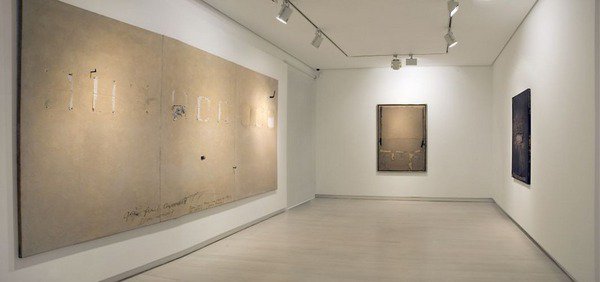Antoni Tapies
dal 18/1/2012 al 30/3/2012
Segnalato da
18/1/2012
Antoni Tapies
Galeria Elvira Gonzalez, Madrid
60's & 70's. In his work from the 1960s and 70s we perceive not only an assuredness in the handling of the form, but also an ideological shift. From the mid 60s well into the 70s, the final years of Franco's regime, his work took on a decidedly political slant. In the seventies his painting transmuted into a truly three-dimensional work and he began to construct and manipulate objects, exploring the limits of their plasticity.

Galería Elvira González is pleased to announce the opening of the exhibition Antoni Tàpies. 60s & 70s on January 19, featuring a selection of works made in the two decades spanning the sixties and seventies by the master of Spanish informalismo and one of the truly seminal names in contemporary art in Europe.
On view at the gallery until 31 March 2012, the exhibition includes large-format mixed media works on various supports from this decisive phase in the artist’s production.
Casting a backwards gaze over the career of Antoni Tàpies (Barcelona, 1923), one readily detects a sense of unity running through his whole body of work, right up until the present moment. In the 1940s and 50s, Tàpies introduced the subjects, themes and tropes he was to explore throughout the remainder of his career. Having said that, and as he himself maintains, it was in the late 1950s when he started to find his stride as a mature artist. As he mined the possibilities of this adopted vernacular, Tàpies’ signature style gelled in the 1960s and 70s, the two key decades under the spotlight in the exhibition at Galería Elvira González.
At the end of the 1950s and throughout the following decade Tàpies started to play with texture, creating his acclaimed “matter-based” works, coupling this exploration of texture with new iconographic motifs, graphemes, footprints and the prints of his own hands on the canvas.
Tàpies co-opted everyday objects and inserted them in his paintings, transmuting them in the process into something else. Akin to an alchemist, Tàpies took perishable, lowly materials and imbued them with new life within the work, conferring them a hitherto unknown permanence and nobility. This fondness for transformation was clearly influenced by Zen, a philosophy the artist was conversant with and which taught him how to lend new meaning to disregarded and overlooked materials. Tàpies’ new treatment of materials also coincides in time with the expansion of arte povera in Europe, and post-minimalism and conceptualism in the USA.
In his work from the 1960s and 70s we perceive not only an assuredness in the handling of the form, but also an ideological shift. From the mid 60s well into the 70s, the final years of Franco’s regime, his work took on a decidedly political slant.
In the seventies his painting transmuted into a truly three-dimensional work and he began to construct and manipulate objects, exploring the limits of their plasticity.
In Què fem? from 1974, Tàpies further explores materials and symbols he had already used in the 1950s. Yet while the prints and incisions from the matter-based paintings from the late 50s had a more geological undergirding, the works from the seventies speak to a more everyday world with a human dimension.A knife incrusted in the work, a belt buckle in the centre, ninen type-written pages torn from the work, bringing to mind a notice board, create a perfectly symmetrical wall. The apparent simplicity of the composition is reinforced by the treatment of the materials and the magnification of the format, responding to the concept of painting as mural.
Scrawled graffiti-like on the lower centre is a quotation from Joan Brossa in which a short sequence of unsettling questions is rejoindered with a simple material fact. Què fem? On anem? D’on venim / Però aquí tenim una caixa de llapis de colors. (What shall we do? Where shall we go? Where do we come from? But here we have a box of coloured pencils).
In the 1950s Tàpies was already attracting international attention thanks to shows at Martha Jackson Gallery in New York and Galerie Maeght in Paris. He took part in the 26th Venice Biennale in 1952 and at the 4th São Paulo Biennial in 1957. His work has been shown at renowned museums and art institutions such as the Museum of Modern Art and the Solomon R. Guggenheim Museum in New York; Neue Nationalgalerie in Berlin; Kunsthaus in Zurich; Museum of Contemporary Art, Los Angeles; Institute of Contemporary Arts and Serpentine Gallery, in London; Musée d’Art Moderne de la Ville, Jeu de Paume and Centre Pompidou in Paris; Museo Nacional Centro de Arte Reina Sofía, Madrid; Institut Valencià d’Art Modern in Valencia; Museu d’Art Contemporani in Barcelona and Dia Art Foundation in New York, among many others.
Tàpies’ creativity expands beyond his painterly and object-based production and since 1947 he has put together a noteworthy body of graphic work. In this regard, it is worth underscoring the fact that the artist has created a large number of folders and bibliophile books in close collaboration with poets and writers like Alberti, Brossa, Dupin, Guillén, Paz, Saramago, Taniguchi and Valente, among others.
A prolific essayist, Tàpies has published extensively with many of his writings translated into several languages: La práctica del arte (1971), El arte contra la estética (1977), Memoria personal (1983), La realidad como arte. Por un arte moderno y progresista (1989), El arte y sus lugares (1999) and Valor del arte (2001).
Galeria Elvira Gonzalez
Calle General Castanos, 3 - Madrid



